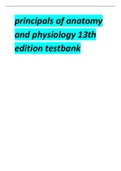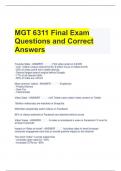principals of anatomy
and physiology 13th
edition testbank
, Full file at http://testbankscafe.eu/Test-Bank-for-Principles-of-Anatomy-and-Physiology-13th-Edition-Tortora
Package Title: Testbank
Course Title: PAP13
Chapter Number: 02
Question type: Multiple Choice
1) What are the four major elements found in the chemicals that comprise the human body?
a) nitrogen, oxygen, calcium, sodium
b) hydrogen, carbon, phosphorus, calcium
c) carbon, hydrogen, oxygen and nitrogen
d) oxygen, nitrogen, potassium, calcium
e) potassium, phosphorus, sodium, hydrogen
Answer: c
Difficulty: Easy
Learning Objective 1: LO 2.1 Understand how the structures of atoms, ions, molecules, free
radicals and compounds are related to the main chemical elements of the human body.
Learning Objective 2: LO 2.1.1 Identify the main chemical elements of the human body.
Section Reference 1: 2.1 How Matter is Organized
2) The three types of subatomic particles that are important for understanding chemical reactions
in the human body are
a) neutrons, quarks, and muons.
b) protons, neutrons, and electrons.
c) muons, positons, and neutrons.
d) electrons, quarks, and protons.
e) positons, protons, and neutrons.
Answer: b
Difficulty: Easy
Learning Objective 1: LO 2.1 Understand how the structures of atoms, ions, molecules, free
radicals and compounds are related to the main chemical elements of the human body.
Learning Objective 2: LO 2.1.2 Describe the structures of atoms, ions, molecules, free radicals,
and compounds.
Section Reference 1: 2.1 How Matter is Organized
3) Which of the following subatomic particles has a neutral charge?
, Full file at http://testbankscafe.eu/Test-Bank-for-Principles-of-Anatomy-and-Physiology-13th-Edition-Tortora
a) neutron
b) electron
c) proton
d) Both neutron and electron.
e) All of these choices.
Answer: a
Difficulty: Easy
Learning Objective 1: LO 2.1 Understand how the structures of atoms, ions, molecules, free
radicals and compounds are related to the main chemical elements of the human body.
Learning Objective 2: LO 2.1.2 Describe the structures of atoms, ions, molecules, free radicals,
and compounds.
Section Reference 1: 2.1 How Matter is Organized
4) What region of an atom contains the protons and neutrons?
a) cloud
b) nucleus
c) element
d) ring
e) shell
Answer: b
Difficulty: Easy
Learning Objective 1: LO 2.1 Understand how the structures of atoms, ions, molecules, free
radicals and compounds are related to the main chemical elements of the human body.
Learning Objective 2: LO 2.1.2 Describe the structures of atoms, ions, molecules, free radicals,
and compounds.
Section Reference 1: 2.1 How Matter is Organized
5) The number of protons in an atom is represented by an element’s
a) mass number.
b) atomic number.
c) atomic mass.
d) valence number.
e) None of these choices.
Answer: b
Difficulty: Easy
, Full file at http://testbankscafe.eu/Test-Bank-for-Principles-of-Anatomy-and-Physiology-13th-Edition-Tortora
Learning Objective 1: LO 2.1 Understand how the structures of atoms, ions, molecules, free
radicals and compounds are related to the main chemical elements of the human body.
Learning Objective 2: LO 2.1.2 Describe the structures of atoms, ions, molecules, free radicals,
and compounds.
Section Reference 1: 2.1 How Matter is Organized
6) The nucleus of unstable _____ of an element will decay leading to emission of radiation.
a) compounds
b) cations
c) anions
d) isotopes
e) molecules
Answer: d
Difficulty: Medium
Learning Objective 1: LO 2.1 Understand how the structures of atoms, ions, molecules, free
radicals and compounds are related to the main chemical elements of the human body.
Learning Objective 2: LO 2.1.2 Describe the structures of atoms, ions, molecules, free radicals,
and compounds.
Section Reference 1: 2.1 How Matter is Organized
7) This refers to a weighted average of the atomic weights of all naturally occurring isotopes of
an element.
a) mass number
b) atomic number
c) atomic mass
d) ionic mass
e) covalent mass
Answer: c
Difficulty: Medium
Learning Objective 1: LO 2.1 Understand how the structures of atoms, ions, molecules, free
radicals and compounds are related to the main chemical elements of the human body.
Learning Objective 2: LO 2.1.2 Describe the structures of atoms, ions, molecules, free radicals,
and compounds.
Section Reference 1: 2.1 How Matter is Organized
Question type: Essay





